Brief

Executive Summary
- The slow pace of customer-centered innovation in insurance has turned into a major setback since Covid-19 accelerated consumers’ migration to digital channels.
- Traditional incumbent insurers lag the insurgents and direct-to-consumer firms in right-first-time digital interactions, which makes for a gap in customer loyalty.
- Brokers’ adoption of digital tools also remains low in most countries, which tends to annoy customers.
- Insurers have no choice but to upgrade the digital experience on four counts: cull the bad and avoidable volume, put the customer in control through better self-service tools, reduce unit costs and digitize sales.
The Covid-19 pandemic presents insurance companies with a watershed moment for their digital initiatives. Although consumers have embraced digital channels and tools in recent years, most insurers have been slow to respond with innovations that make key customer episodes—such as product research, purchase, service and claims—simple and convenient.

Macro Surveillance Platform
For more detail on the business implications of coronavirus from Bain’s Macro Trends Group, log on to the Macro Surveillance Platform. Learn more about the platform >
The slow pace of customer-centered innovation has turned into a major setback since the Covid-19 pandemic accelerated consumers’ migration to digital channels. Digital adoption grew 20% globally over the past year, almost four times the compound annual growth rate of the prior four years, according to Bain & Company’s new survey, conducted by Dynata. The survey covered 135,000 consumers in 17 countries (see Figure 1 for select countries).
Covid-19 has accelerated customers’ adoption of digital channels

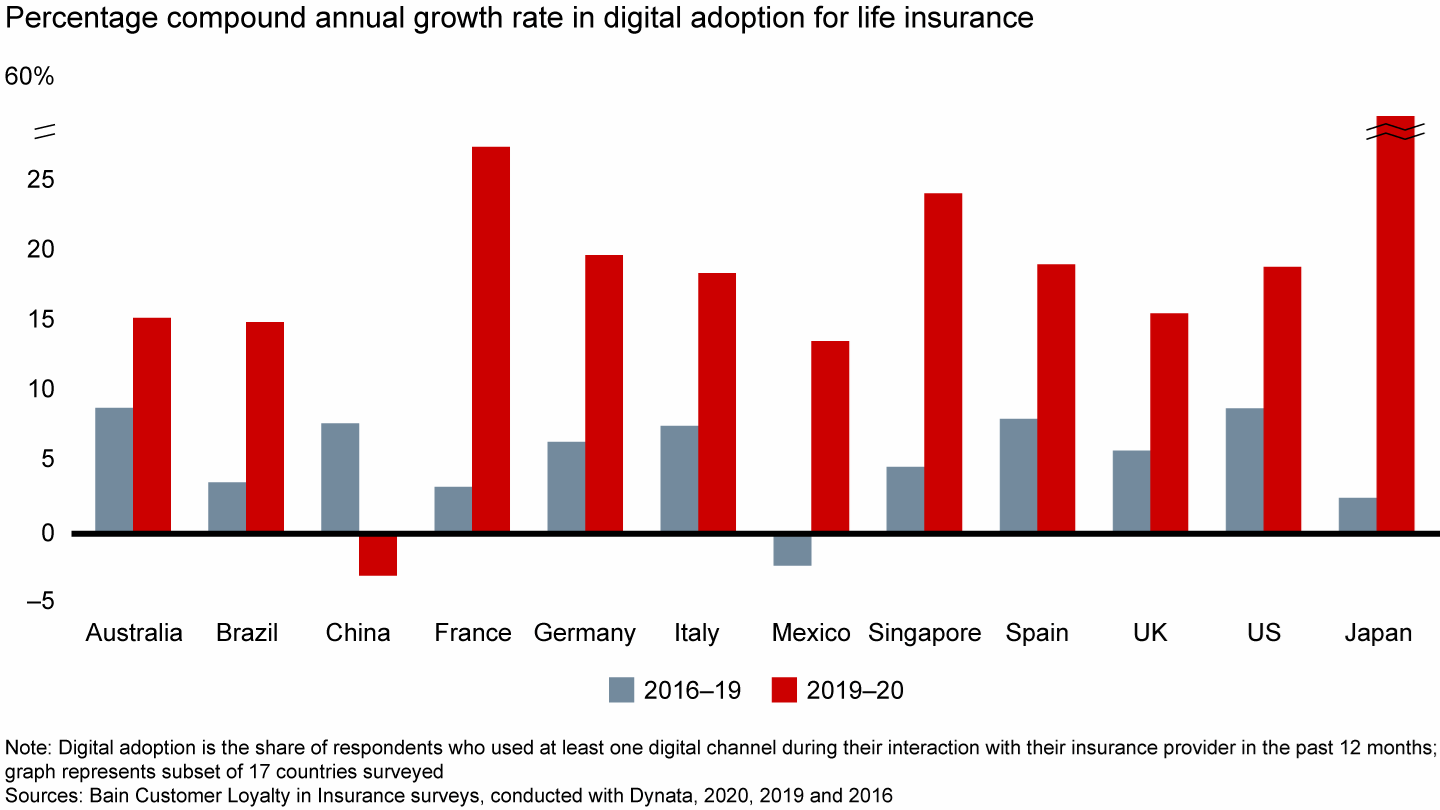
Among the leading innovators, most are digital-only businesses. HUK 24 in Germany, for instance, offers real-time assistance via mobile apps along with quick interactions between customer and service agents via social media and blogs. Consumers purchasing an HUK 24 product cited the company’s user friendliness by way of easy documentation, and the short time needed to complete an interaction, our survey found.
Lemonade, which offers renters’ and homeowners’ policies in the US, runs many customer interactions through bots imbued with artificial intelligence (AI). Lemonade’s Maya bot asks basic questions through the user interface in order to design customized policies. The Jim bot reviews all claims, which customers take about two minutes to file, cross-references the claim to a policy, runs 18 antifraud algorithms and pays customers in as little as three seconds.
The value of right-first-time
Indeed, most digital leaders in property and casualty (P&C)—companies with high customer digital adoption and high loyalty in the form of their Net Promoter Score℠—still consist of young, direct-to-consumer companies (see Figure 2). By contrast, incumbent firms that have been able to achieve relatively high digital adoption also tend to have higher failure rates in their digital interactions, which means customers have to switch to phone or in-person channels in order to complete the transaction.
Most digital leaders in P&C sell direct to consumers, while traditional incumbents with high digital adoption have low loyalty scores
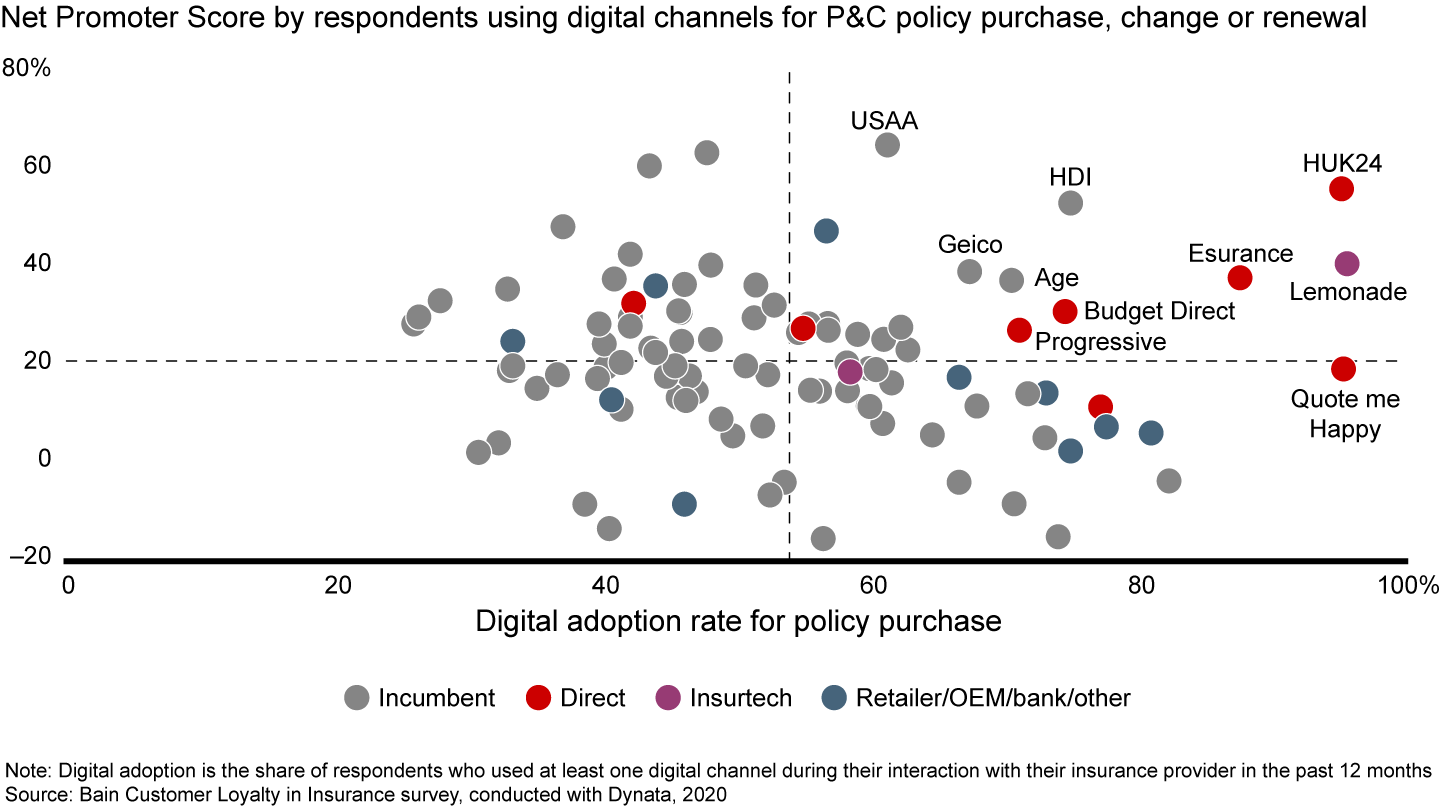
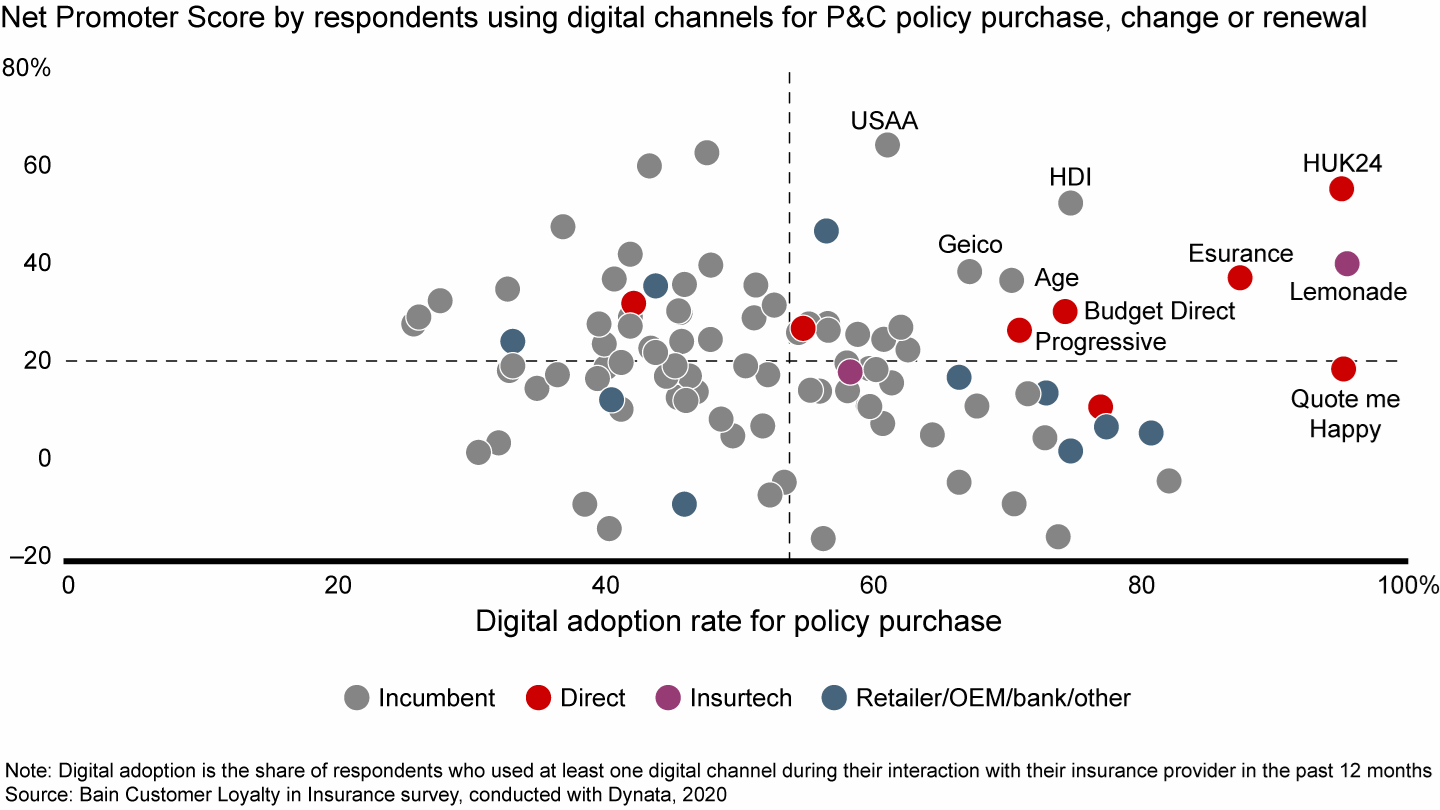
Yet tradition and legacy systems are no excuse, as a few incumbents also managed to set the pace for reliable digital channels and tools. For example, Geico in the US uses telematics to price behavior-based auto insurance, and it relies on AI to improve renters’ insurance close rates by 40% in its call centers. Within Geico’s policy management and billing system, customers can make changes online and get clear communication of the renewal price. Such innovations have helped Geico achieve a 12% compound annual growth rate in direct written premiums from 2015 through 2019, vs. a 4.5% CAGR for the overall P&C market.
Among all insurers, customers experience the most problems with digital claims interactions, where they need personal help or found the process difficult (see Figure 3). Millennials report a higher share of failed digital interactions than do older respondents, perhaps because millennials have higher expectations for a digital experience.
P&C customers encounter the most problems in digital claims interactions
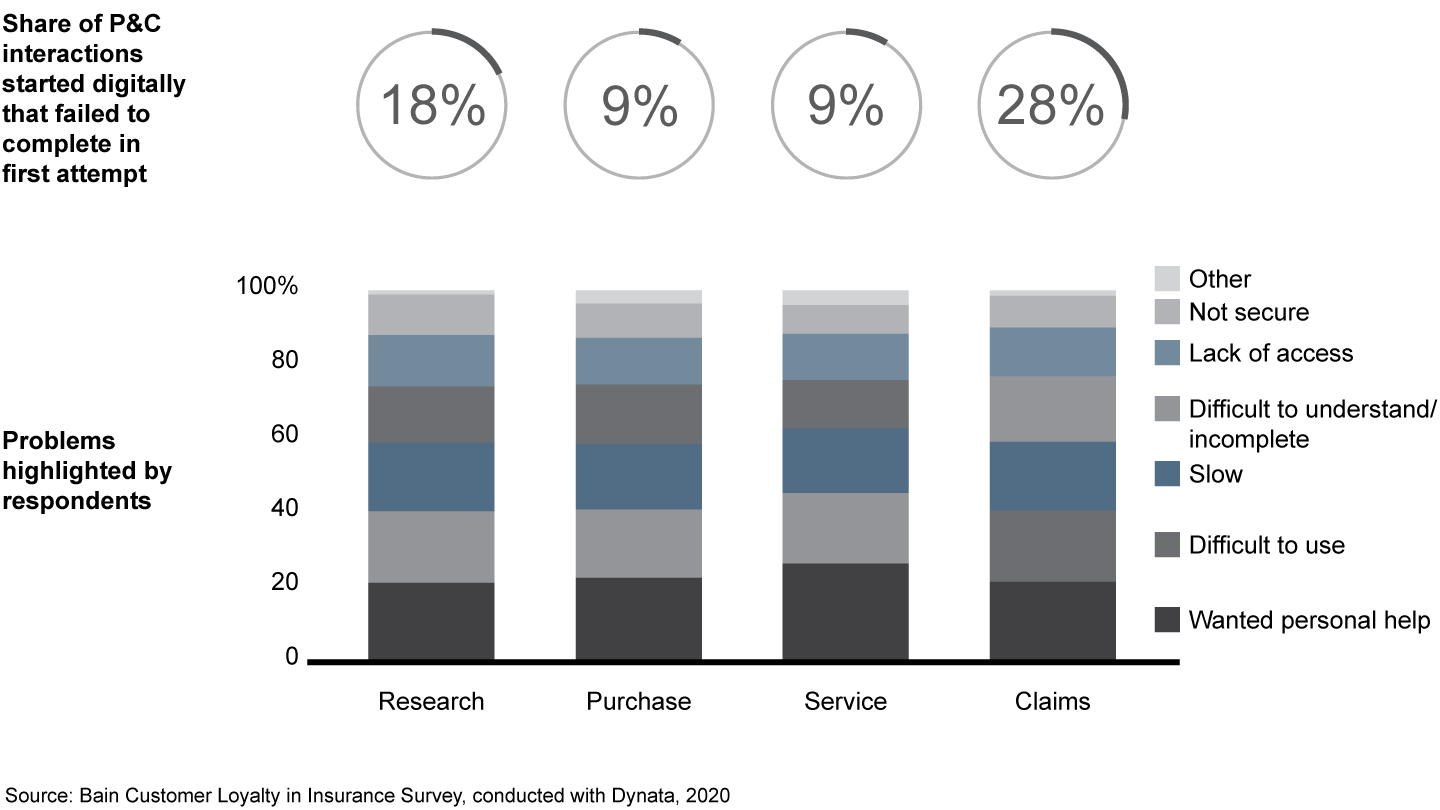
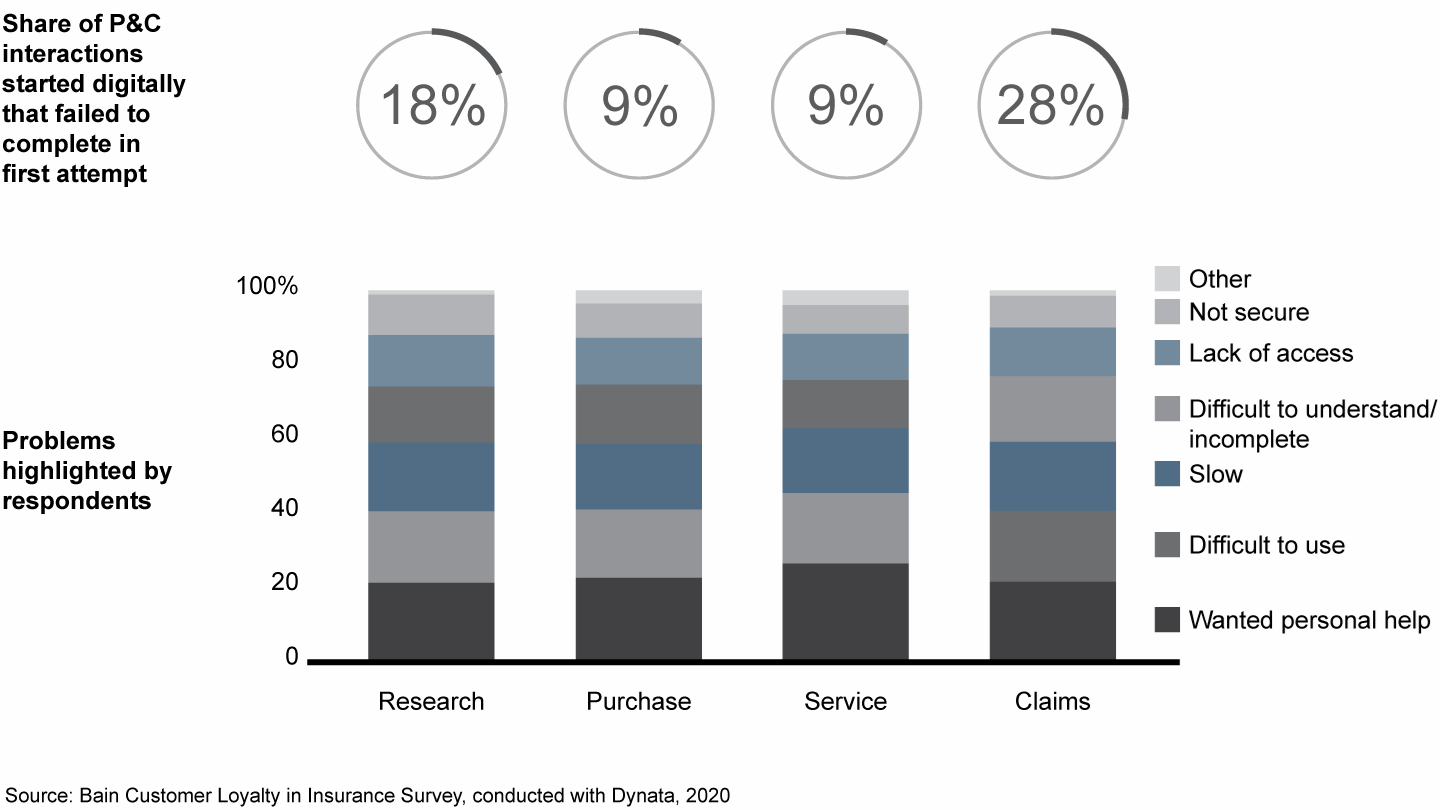
Improving the digital experience not only reduces costs by shifting more transactions away from labor-intensive phone calls and in-person visits. Convenient digital episodes that go right the first time also appeal to consumers. All else equal, seamless digital interactions earn greater loyalty from consumers in most countries and for most P&C episodes (see Figure 4).
Customers who encountered problems in their digital interactions tend to give their insurer lower loyalty scores
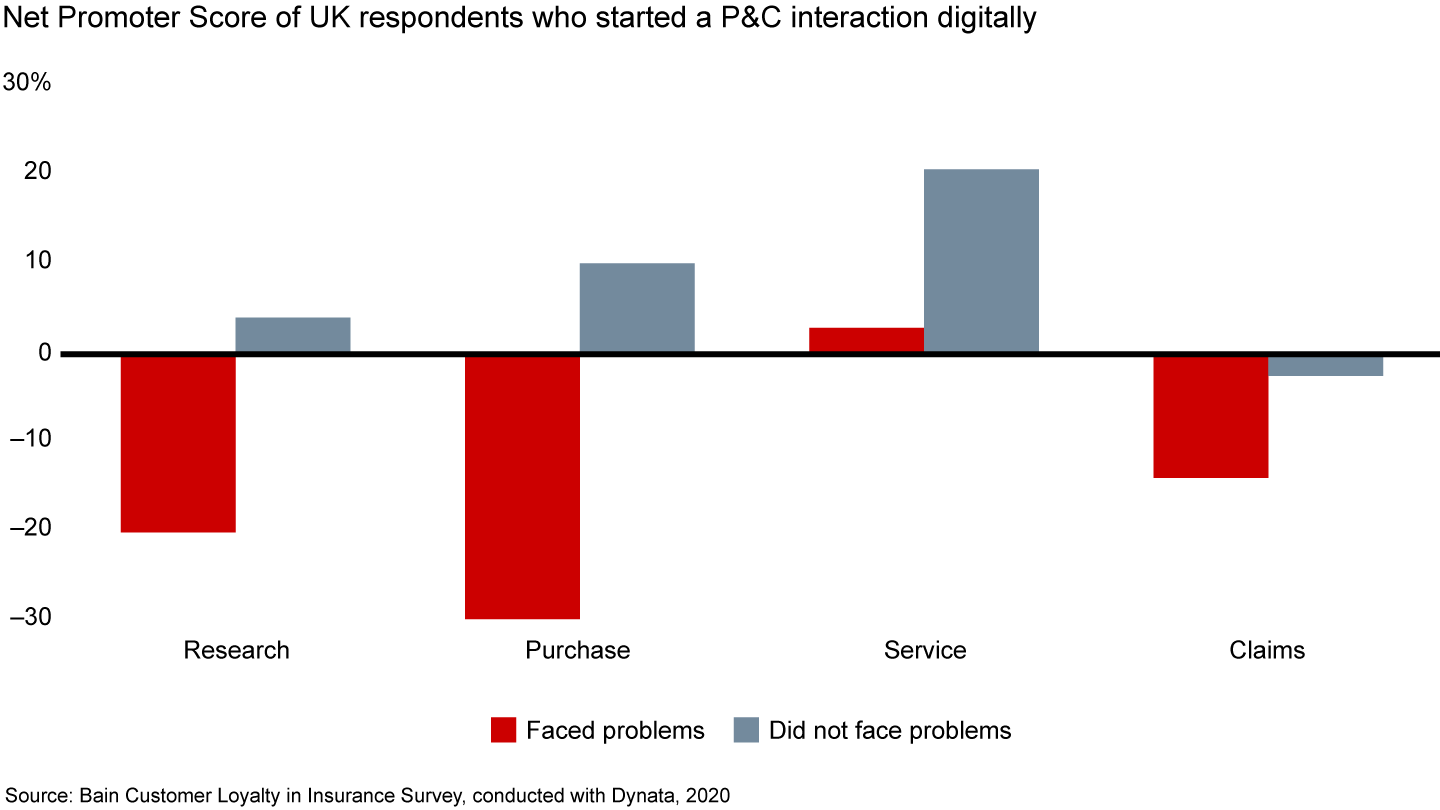
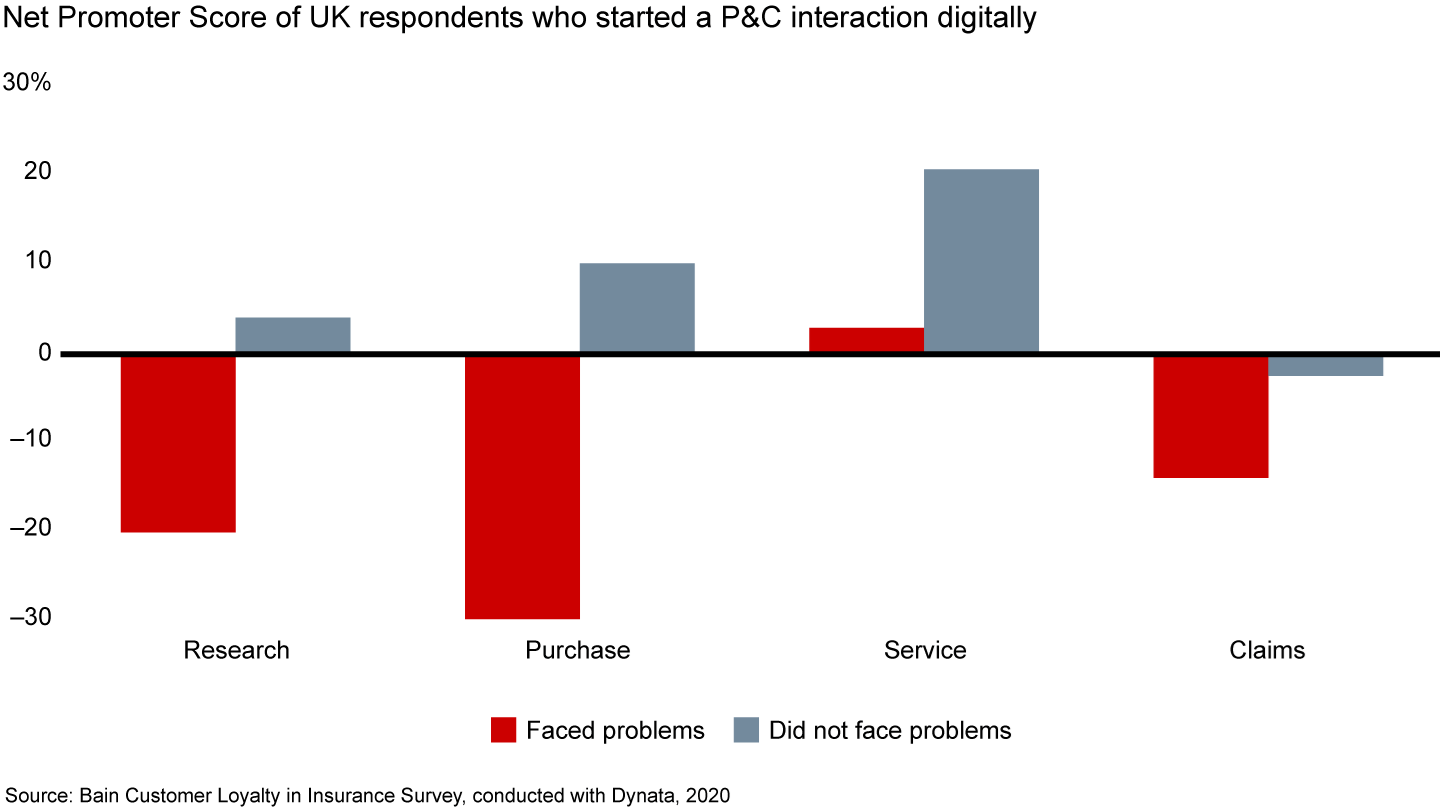
Leading insurers invested ahead of the curve in state-of-the-art digital assets, our recent benchmarking of 104 executives in life and P&C in the US, UK and Australia finds. For instance, the leaders are 1.7 times more likely than other insurance companies to have a cutting-edge website and customer service portal. They are 2.8 times more likely to offer instant online approval or rejection of an application for auto insurance. And they have broader digital offerings, including video.
These leaders use data and feedback to refine their interactions in ways that appeal to consumers. For example, they are twice as likely to have simple products and effortless customer episodes. To that end, they have recently redesigned 61% of their episodes and have scheduled the rest for redesign soon.
Despite the rise of digital channels, many customers continue to rely on offline channels as well. For example, people want personal advice and assistance during claims interactions, and when researching and buying life insurance. Yet here too, digital tools have their place, giving advisers relevant information and helping them coach customers to use digital channels themselves.
Brokers’ digital gaps
Unfortunately, independent brokers’ adoption of digital tools for customers remains low in most countries. Only about 20% on average of brokers in the US, UK and Canada offer any form of mobile apps or self-service portals, according to an Applied Systems survey. While the coronavirus situation has increased brokers’ digital engagement, there is ample room for them to improve and thereby build relationships with prospective customers. For example, survey respondents whose agent or broker uses digital tools give a Net Promoter Score 17 points higher than respondents whose agent or broker does not do so during research for a life policy.
Companies can shift their agents and brokers to digital quickly. In the wake of the Covid-19 outbreak, Max Life in India digitally trained more than 9,000 sellers and 25,000 agents in two weeks to allow them to conduct virtual sales. Roughly 80% of employees were able to switch to remote work in a few days, equipped with virtual desktops and upgraded links. The salesforce sold 24,000 policies in a single week during lockdown.
Even the most reluctant agents can be won over. In Germany, one insurer changed its incentive system to persuade a skeptical salesforce to accept online channels. The company set new compensation rules for digitally closed contracts, while continuing to reward high performers.
To view the pandemic’s challenges as affording an opportunity for insurers would be too charitable. Realistically, they have no choice but to substantially upgrade the digital experience. Consumers demand more and better digital interactions, and web searches and aggregator sites make it far easier to switch providers.
Four goals for digital
Gathering and analyzing customer data to understand behavioral changes will set up insurers to accelerate digital investments that improve the experience. They can focus digital initiatives on four goals:
1. Cull the bad and avoidable volume. Avoid episodes that annoy consumers. For instance, automatic status updates will reduce inquiry calls, and digital applications will reduce incomplete forms. Use AI-imbued automation to reduce false positive fraud alerts. And for all interactions, get it right the first time so as to avoid rework.
2. Put the customer in control. Educate customers about self-serve options. Increase their use of mobile apps by embedding useful, personalized data in the apps. Offer digital support to mitigate phone calls. Raise employees’ and brokers’ digital adoption rates through training, coaching and, if necessary, incentives.
3. Simplify to reduce unit costs and raise productivity. Radically simplify processes, products, policies, using automation where appropriate. Aim for straight-through-processing to eliminate manual work in the back office.
4. Bring sales into the digital age. Web searches for insurance-policy topics such as “online car insurance” have soared in recent months. This clear demand underscores the need to build out digital sales channels including online applications. Companies should also equip agents with three other things: digital sales tools, lead management systems built on CRM systems and analytics that can inform intelligent, next-best-offer campaigns.
Social media plays a role as well; at one annuity company, adviser performance in the second quarter varied widely, from down 60% to up 90% compared with the year earlier. The difference largely came down to using Facebook effectively.
Insurgent firms such as Toffee, CoverWallet and Ladder may continue to poach slices of the insurance market with digital innovations that feature simplicity, speed and sometimes lower-priced offerings. To be sure, many of the insurgent companies have yet to prove that they will endure with continued gains in market share, or attain profitable growth. And some might eventually be acquired.
Incumbents have their own assets—data generated from huge customer bases, ample capital and well-known brands—to rely on. Now the pandemic accentuates a gap in digital capabilities that lagging companies must close in order to maintain or grow market share when the economy eventually recovers.
Net Promoter®, NPS®, and the NPS-related emoticons are registered trademarks of Bain & Company, Inc., Satmetrix Systems, Inc., and Fred Reichheld. Net Promoter Score℠ and Net Promoter System℠ are service marks of Bain & Company, Inc., Satmetrix Systems, Inc., and Fred Reichheld.

Coronavirus
The global Covid-19 pandemic has extracted a terrible human toll and spurred sweeping changes in the world economy. Across industries, executives have begun reassessing their strategies and repositioning their companies to thrive now and in the world beyond coronavirus.

About the Research
Data powered by Dynata, a leading global first-party data and insights platform.